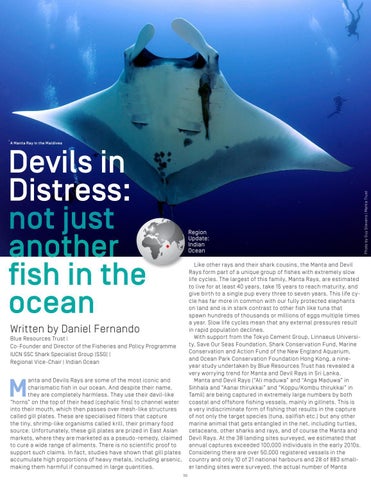Devils in Distress: not just another fish in the ocean
Region Update: Indian Ocean Like other rays and their shark cousins, the Manta and Devil Rays form part of a unique group of fishes with extremely slow life cycles. The largest of this family, Manta Rays, are estimated to live for at least 40 years, take 15 years to reach maturity, and give birth to a single pup every three to seven years. This life cycle has far more in common with our fully protected elephants on land and is in stark contrast to other fish like tuna that spawn hundreds of thousands or millions of eggs multiple times a year. Slow life cycles mean that any external pressures result in rapid population declines. With support from the Tokyo Cement Group, Linnaeus University, Save Our Seas Foundation, Shark Conservation Fund, Marine Conservation and Action Fund of the New England Aquarium, and Ocean Park Conservation Foundation Hong Kong, a nineyear study undertaken by Blue Resources Trust has revealed a very worrying trend for Manta and Devil Rays in Sri Lanka. Manta and Devil Rays (“Ali maduwa” and “Anga Maduwa” in Sinhala and “Aanai thirukkai” and “Koppu/Kombu thirukkai” in Tamil) are being captured in extremely large numbers by both coastal and offshore fishing vessels, mainly in gillnets. This is a very indiscriminate form of fishing that results in the capture of not only the target species (tuna, sailfish etc.) but any other marine animal that gets entangled in the net, including turtles, cetaceans, other sharks and rays, and of course the Manta and Devil Rays. At the 38 landing sites surveyed, we estimated that annual captures exceeded 100,000 individuals in the early 2010s. Considering there are over 50,000 registered vessels in the country and only 10 of 21 national harbours and 28 of 883 smaller landing sites were surveyed, the actual number of Manta
Written by Daniel Fernando Blue Resources Trust | Co-Founder and Director of the Fisheries and Policy Programme IUCN SSC Shark Specialist Group (SSG) | Regional Vice-Chair | Indian Ocean
M
anta and Devils Rays are some of the most iconic and charismatic fish in our ocean. And despite their name, they are completely harmless. They use their devil-like “horns” on the top of their head (cephalic fins) to channel water into their mouth, which then passes over mesh-like structures called gill plates. These are specialised filters that capture the tiny, shrimp-like organisms called krill, their primary food source. Unfortunately, these gill plates are prized in East Asian markets, where they are marketed as a pseudo-remedy, claimed to cure a wide range of ailments. There is no scientific proof to support such claims. In fact, studies have shown that gill plates accumulate high proportions of heavy metals, including arsenic, making them harmful if consumed in large quantities. 50
Photo by Guy Stevens | Manta Trust
A Manta Ray in the Maldives



















